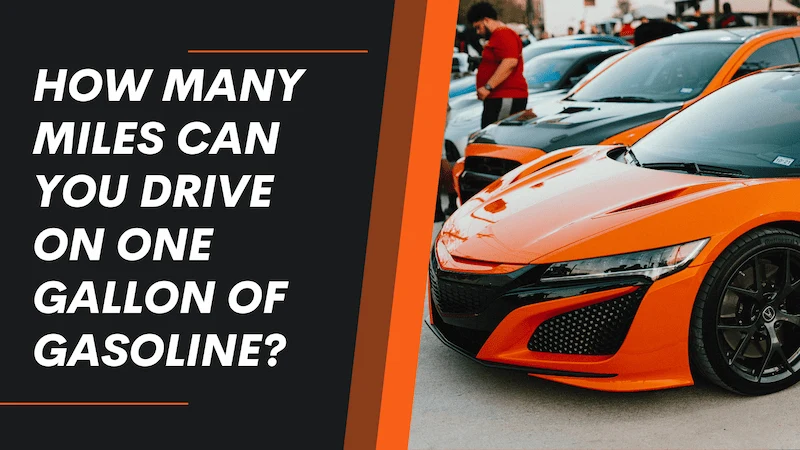Several factors will affect “how many miles can you drive on one gallon of gasoline?” Knowing your car’s MPG (miles per gallon) helps you keep track of how much gas you use on each trip and ultimately saves you money.
Above all, one gallon of gas should enable you to travel between 20 and 30 miles. However, some cars can go up to 60 miles per gallon. Your car’s efficiency is impacted by a number of factors when it comes to mileage. Car weight, poor driving practices, the environment, and inadequate maintenance are a few of the contributing factors.
Keep reading.
How Many Miles Can Your Car Travel Per Gallon of Gas?
Your car is estimated to travel between 20 to 30 miles on a gallon of gas. Nonetheless, it is not unusual to find vehicles that go beyond the 30-mile mark, with some reaching up to 60 miles.
There is no universal formula for calculating mileage. Ultimately, a number of factors will decide how many miles per gallon of gas a car can travel.
Running your car on a low tank is not a good idea for drivers, regardless of whether they get better gas mileage or not. Either you run the risk of getting lost, or your engine gets hurt.

Factors That Affect How Many Miles Per Gallon Your Car Gets
The truth is that there are a number of variables that can impact how much gas your car will actually use per mile. Factors such as:
- Wind creates resistance, which requires the engine to work harder, increasing how many gallons a mile your car will use.
- Rapid acceleration after stopping at a traffic light will use more gas than if you speed up gradually.
- Idling due to traffic jams or to warm up your car wastes gas. This will decrease how many miles in a gallon your car can travel, so it’s best to keep idling to a minimum whenever possible.
- Speed will affect how far you can go on a gallon of gasoline. Oak Ridge National Laboratory study found that speeds between 40 and 50 miles per hour is the optimum cruising speed for high fuel economy in cars and light trucks.
- Under inflated tires can reduce your gas mileage by 0.4 percent for every 1-psi drop in pressure.
While 20 mpg may not seem like much, it is significantly more than what vehicles from the 1990s could manage.
But when considering how many miles for 1 gallon of gas can take you, it’s best to account for any changes in weather or driving habits. The last thing you want is to run out of gas while you’re a long way from a gas station!
How to Calculate Your Vehicle’s MPG?
For tracking your gas mileage, it’s essential to know how to calculate your car’s miles per gallon accurately.
These easy steps will help you determine your car’s MPG.
- Fill up your tank
Start by filling your tank with gas then proceed to reset your trip odometer or record the mileage on a piece of paper.
- Drive till refill time
Drive your car as you normally would until a refill is required. When your tank is less than halfway full, you should refill.
- Fill up your tank again
While refilling your tank the second time, pay close attention and take note of the number of gallons it took to fill the tank. This number represents the number of gallons you used since the last fill-up.
- Record mileage
As soon as you’ve refilled your gas tank a second time, note your mileage or note the new odometer reading.
- Calculate
Subtract the mileage of the first fill-up from the mileage of the second to start your calculations. You can calculate how many miles you have traveled since your last gas fillup by subtracting the sum of the two numbers.
Subtract the result from the quantity of gallons used to fill your tank. This will give you your car’s MPG.

How to Improve Your Car’s Gas Economy?
Improving your car’s gas economy is achievable if you stick to the following tips:
- Avoid excessive braking, excessive acceleration, and excessive speeding.
- Take care not to idle too much. If you have to wait for more than a couple of minutes, turn off your engine.
- Don’t load your car up with more weight than is advised.
- Use cruise control to maintain a constant speed on the highway.
- Replace faulty spark plugs.
- Follow the manufacturer’s or a technician’s advice regarding routine maintenance.
- Look for wheel misalignment.
Is Running on Empty Bad for Your Car? What Could Happen?
- Get Stranded
The fact that you might run out of fuel at any moment is the most obvious deterrent to driving on empty. If the car’s gas runs out, the engine will shut off and leave you stranded wherever you are. You might not always be left in a safe environment.
Along with finding a secure parking spot quickly, you’ll also need to figure out how to put gas in the car. This is much more of a hassle than simply adding fuel while you can, whether you choose to wait for roadside assistance or walk to a nearby station.
- Clog Fuel Filter
More dirt, sediment, and debris will be drawn in if the gas tank is allowed to sink all the way to the bottom. These grits typically settle at the tank’s bottom, where they don’t usually cause issues.
However, if the pump starts to pull the particles in, they will get trapped in the fuel filter. Performance problems will result from a clogged fuel filter as the gasoline flow will be slowed.
- Damage Fuel Pump
The filter is in place to stop those contaminants from getting into the pump, but it can still happen. The fuel pump is built to last the lifetime of the vehicle, but running your tank dry will prevent that from happening.
In addition, a pump without the proper lubrication can become overheated. Because the tank needs to be drained, which requires additional labor, the cost of replacing the pump may exceed $1,000. Instead, stop before the tank gets low and put some fuel in the tank. It’s comparable to having a costly repair insurance policy.
- Create Engine Damage
The fuel pump has the potential to inhale air as the vehicle begins to run on empty. When this happens, the engine’s air-fuel ratio is out of balance.
Initial misfiring may be apparent. But if you keep driving your car in this manner, you’ll only need to pay for expensive engine repairs.

FAQs
How Much is a Gallon?
A gallon equals 4 quarts, 8 pints, or 128 fluid ounces. Abbreviation for gallon: gal.
How Many Miles Can You Drive on 2.5 Gallons of Gas?
With average fuel consumption of 22 miles per gallon, you can drive 55.00 miles on 2.5 gallon(s)
How Many Gallons of Gas is $50?
If you spend $50, you’d be able to get nine gallons. The average car gets 24.2 miles per gallon, according to the U.S. Department of Energy. That means you’d be able to, on average, go 215 miles roundtrip.
How Long Does a Full Tank of Gas Last While Driving?
It depends on what fuel mileage the vehicle gets, how big the fuel tank is and how much you drive it. Typically a car would have a tank that would hold enough fuel to go 300 miles comfortably.
Summary: How Many Miles Can You Drive on One Gallon of Gasoline?
Knowing how many miles your car can travel on one tank of gas is a key component of safe driving. That way, you’ll know how often you need to stop at a gas station to fill the tank. Additionally, you’ll be able to figure out how much gas you’ll need for a road trip or daily commute to work.
But keep in mind that even though modern cars can go 20 to 30 miles on a single gallon of gas, this estimate is greatly influenced by how well the car is maintained, the driver’s style, and the environment in which they are driven.
If you have any questions, please leave a comment. KV Auto tries to give you the best car industry information. Thank you for reading.





